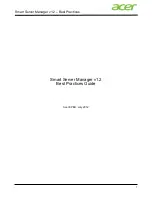
BGP Route
A
BGP route
consists of two parts, a prefix and a set of path attributes. It is not uncommon
to use the term
path
to refer to a BGP route, although that term technically refers to one
of the path attributes of that route.
Routing Information Base
BGP routes are stored in a BGP speaker’s routing information base (RIB), also known as
its routing table, which conceptually consists of the following three parts:
•
Adj-RIBs-In store unprocessed routes learned from update messages received by the
BGP speaker.
•
Loc-RIB contains local routes resulting from the BGP speaker applying its local policies
to the routes contained in its Adj-RIBs-In.
•
Adj-RIBs-Out store routes that the BGP speaker will advertise to its peers in the update
messages it sends.
Prefixes and CIDR
A
prefix
describes a set of IP addresses that can be reached using the route. For example,
the prefix 10.1.1.0/24 indicates all IP addresses whose first 24 bits contain the value 10.1.1.
The term
network
is sometimes used instead of
prefix
to describe a set of addresses. To
reduce confusion, this chapter restricts
network
to its more common usage, to refer to a
physical structure of routers and links.
Prefixes are made possible by classless interdomain routing (CIDR). CIDR addresses
have largely replaced the concept of classful addresses (such as Class A, Class B, and
Class C) in the Internet. Classful addresses have an implicit, fixed-length mask
corresponding to the predefined class boundaries. For example, 192.56.0.0 is a Class B
address with an implicit (or natural) mask of 255.255.0.0.
CIDR uses network prefixes and explicit masks, represented by a prefix length, enabling
network prefixes of arbitrary lengths. CIDR represents the sample address above as
192.56.0.0/16. The /16 indicates that the high-order 16 bits (the first 16 bits counting from
left to right) in the address mask are all 1s.
CIDR enables you to aggregate multiple classful addresses into a single classless
advertisement, reducing the number of advertisements that must be made to provide
full access to all the addresses. Suppose an ISP has customers with the following
addresses:
192.168.128.0
192.168.129.0
192.168.130.0
192.168.131.0
9
Copyright © 2010, Juniper Networks, Inc.
Chapter 1: Configuring BGP Routing
Summary of Contents for JUNOSE 11.2.X BGP AND MPLS
Page 6: ...Copyright 2010 Juniper Networks Inc vi...
Page 8: ...Copyright 2010 Juniper Networks Inc viii JunosE 11 2 x BGP and MPLS Configuration Guide...
Page 38: ...Copyright 2010 Juniper Networks Inc 2 JunosE 11 2 x BGP and MPLS Configuration Guide...
Page 192: ...Copyright 2010 Juniper Networks Inc 156 JunosE 11 2 x BGP and MPLS Configuration Guide...
Page 242: ...Copyright 2010 Juniper Networks Inc 206 JunosE 11 2 x BGP and MPLS Configuration Guide...
Page 244: ...Copyright 2010 Juniper Networks Inc 208 JunosE 11 2 x BGP and MPLS Configuration Guide...
Page 310: ...Copyright 2010 Juniper Networks Inc 274 JunosE 11 2 x BGP and MPLS Configuration Guide...
Page 356: ...Copyright 2010 Juniper Networks Inc 320 JunosE 11 2 x BGP and MPLS Configuration Guide...
Page 418: ...Copyright 2010 Juniper Networks Inc 382 JunosE 11 2 x BGP and MPLS Configuration Guide...
Page 524: ...Copyright 2010 Juniper Networks Inc 488 JunosE 11 2 x BGP and MPLS Configuration Guide...
Page 544: ...Copyright 2010 Juniper Networks Inc 508 JunosE 11 2 x BGP and MPLS Configuration Guide...
Page 608: ...Copyright 2010 Juniper Networks Inc 572 JunosE 11 2 x BGP and MPLS Configuration Guide...
Page 672: ...Copyright 2010 Juniper Networks Inc 636 JunosE 11 2 x BGP and MPLS Configuration Guide...
Page 674: ...Copyright 2010 Juniper Networks Inc 638 JunosE 11 2 x BGP and MPLS Configuration Guide...
Page 716: ...Copyright 2010 Juniper Networks Inc 680 JunosE 11 2 x BGP and MPLS Configuration Guide...
Page 717: ...PART 6 Index Index on page 683 681 Copyright 2010 Juniper Networks Inc...
Page 718: ...Copyright 2010 Juniper Networks Inc 682 JunosE 11 2 x BGP and MPLS Configuration Guide...
















































